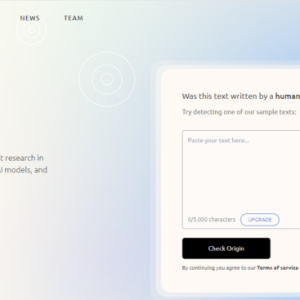Artificial intelligence (AI) has become a game-changer for businesses looking to streamline operations, improve customer experiences, and drive growth. With the market flooded with a variety of AI solutions, choosing the right one for your business can be overwhelming. From chatbots to predictive analytics, the options are endless. It is crucial to carefully evaluate your business needs, goals, and budget before selecting an AI solution that aligns with your objectives. In this article, we will discuss key factors to consider when choosing the right AI solution for your business to help you make an informed decision and maximize the benefits of AI technology.
We’re in an age where digital transformation is more than a trend — it’s a necessity — and so businesses across the globe are turning to artificial intelligence to streamline operations, enhance customer experience and basically increase efficiency. As you’ve no doubt seen, there are a lot of AI solutions for your business on the market.
You are viewing: Choosing the Right AI Solution for Your Business
But with all the AI technologies available, it can be very daunting to figure out which ones to use and which are just a waste of money.
From improving customer service with chatbots to optimizing supply chain management through predictive analytics, the potential applications of AI are as diverse as they are transformative.
Don’t worry – the abundance of options and vendors can overwhelm even the most tech-savvy leaders!
So this article aims to demystify the process of selecting the ideal AI solution for your business by breaking down the journey into manageable steps: understanding your needs, exploring AI technologies, evaluating solution providers, implementing AI solutions, and measuring success.
Help Me Transform My Business with AI
What Exactly Are “AI Solutions”?
“AI solutions” refer to technologies and systems (generally called “tools”) that leverage artificial intelligence to address specific business needs or challenges. These solutions encompass a wide range of applications that use AI algorithms, machine learning, deep learning and natural language processing (NLP).
AI solutions can include but are not limited to:
- Chatbots and virtual agents for customer service and support
- Fraud detection systems in the finance industry
- Personalized recommendation engines in e-commerce
- Autonomous vehicles powered by computer vision technology
- Predictive models for public sector planning
- Healthcare applications like early disease detection through image recognition
These artificial intelligence technologies are designed to make data-driven decisions, automate repetitive tasks, improve customer experiences, increase productivity and drive innovation within organizations.
Some more specific examples of AI solutions for businesses include:
- Smart Products: AI-powered smart products like lightbulbs and thermostats that enhance efficiency and convenience in daily life.
- Delivery and Travel: AI has transformed product delivery and travel services, such as Walmart’s Express Delivery, by offering faster order fulfillment.
- CRM Systems: AI can enhance Customer Relationship Management (CRM) systems – such as Salesforce, Pipedrive and HubSpot – by automating processes and improving relationship management.
- Conversational Ads: Businesses can create conversational ads using AI technology like LivePerson, which helps engage consumers through personalized interactions.

- AI in Marketing: AI-powered tools like chatbots, automated ad buying and keyword search technologies are widely used in marketing strategies.
- Contact Center Technology: Companies like Nextiva use AI to improve customer experiences by providing voice and speech engines for customer insight:

- AI-Powered Assistants: Tools like EliseAI use AI assistants to handle communication tasks, reschedule meetings and send follow-up messages.

- Supply Chain Optimization: AI algorithms forecast supply needs, optimize supply chain operations and minimize overstocking risks.
- HR Functions: AI systems help in writing job postings and creating personalized training programs for employees.
- Industry-Specific Applications: In healthcare, finance, industrial maintenance, transportation and other sectors, AI is used for various specialized needs like diagnostic tools in healthcare and predictive maintenance in industries.
As you can see, there are diverse applications of artificial intelligence solutions across different business functions.
Benefits of Using AI Solutions
There are plenty of benefits of using AI solutions in business, some of which you’re probably already enjoying.
Here are just a few:
- Improved Decision-Making: Enables organizations to make data-driven decisions, leading to better accuracy and reduced reliance on individual instincts or biases.
- Efficiency and Productivity Gains: Allows businesses to handle tasks at a scale and speed beyond human capacity, freeing up employees from time-consuming manual tasks to focus on higher-level work.
- Enhanced Speed of Business: Accelerates business operations, helping companies move faster in the digital age and deliver value to customers more efficiently.
- Industry-Specific Improvements: Fuel industry-specific enhancements like targeted marketing efforts, efficient supply chain management, fraud detection in finance, and drug discovery in the pharmaceutical sector.
- Cost Savings and Profitability: Small businesses especially benefit from AI tools that offer cost-effective solutions driving savings and improved productivity, which helps them compete with larger brands.
- Time Savings: Help redirect resources to higher-value work by automating repetitive tasks.
- Innovation and Growth Opportunities: Businesses use cost savings from AI to invest in new technologies or pursue growth opportunities.
- Reduction of Errors: AI technologies lead to a decrease in errors and ensure stronger adherence to established standards when integrated with business processes.
- Revenue Growth: AI solutions like recommendation algorithms can increase revenue for businesses through cost optimization and improved sales strategies.
So now let’s go through the basic steps of choosing the right AI solution for your business.
Step 1: Understand Your Business Needs
Before rushing out and integrating AI into your business, it’s important to first thoroughly assess your internal operations, your customer needs, your market challenges – or any other areas in which you need help.

This step is about pinpointing where AI can deliver the most value and how it aligns with your broader business objectives. To do that:
- Identify Pain Points: Start by identifying the bottlenecks and inefficiencies within your current operations. Whether it’s slow customer service response times, inaccurate inventory management or cumbersome manual processes, understanding these pain points will guide you towards the AI solutions that can address them effectively.
- Define Your Goals: Clearly define what success looks like for your AI implementation. Are you aiming to enhance customer satisfaction, increase operational efficiency, drive revenue growth? Your goals will not only influence the type of AI solution you choose, but also how you measure its impact.
- Understand AI Capabilities: Gain a basic understanding of what AI can and cannot do. For instance, it’s great at pattern recognition and data analysis, but terrible at creative or innovative thinking. Remember, AI is a tool, not a magic wand; it requires proper integration and management to yield results.
- Consider Your Team’s Skills and Adaptability: The success of AI implementation is also dependent on your team’s ability to adapt to and work with new technologies. Evaluate your team’s current skillset to see what kind of training might be required. You might need to hire new talent specialized in AI technologies.

- Consult with Stakeholders: Engage with various stakeholders across your organization to gather insights and perspectives. This includes IT professionals, frontline employees and even customers. Their input can provide valuable context and ensure that the chosen AI solution addresses the needs of all parties involved.
- Perform a Competitive Analysis: Look at how your competitors are using AI to their advantage. This can give you insights into how you might use it and help you identify areas where AI can give you a competitive edge.
Help Me Transform My Business with AI
Step 2: Explore the Types of AI Solutions
Now that you understand where your business can best use AI, you’ll need to figure out which type of AI technology will be most useful.
See more : The Ultimate Guide to AI for Bloggers
Let’s take a look at the primary categories of AI and their potential applications in business:
Machine Learning (ML): Machine learning algorithms learn from data to make predictions or decisions without being explicitly programmed for each task. ML is at the heart of many AI systems: it significantly enhances predictive analytics, customer segmentations and fraud detection by uncovering insights from vast datasets.

Natural Language Processing (NLP): NLP technologies understand, interpret and generate human language, making them invaluable for customer service automation, sentiment analysis and content creation. Chatbots and virtual assistants powered by NLP can provide personalized customer interactions at scale.

Computer Vision: This technology enables machines to interpret and make decisions based on visual data. Applications range from quality control in manufacturing to retail analytics, where computer vision can track inventory levels or customer interactions with products in real-time.
An example of how computer vision technology enables machines to interpret and make decisions based on visual data is the use of automated retail checkout systems. Items are automatically identified and processed without the need for manual barcode scanning.

Robotic Process Automation (RPA): RPA tools automate routine and repetitive tasks, thereby streamlining operations across various departments such as HR, finance and customer service. For instance, RPA is widely used for tasks such as invoice processing, customer onboarding, HR management, data entry, processing transactions, managing records, and sending emails without human intervention.

AI-Driven Analytics: Advanced analytics solutions powered by AI can transform data into actionable insights, guiding decision-making with predictive models and sophisticated data visualizations. These tools are essential for businesses aiming to leverage their data for competitive advantage.

Each of these AI technologies offers unique benefits and can be applied to solve specific business challenges. As we continue through the process of choosing the right AI solution, keep these technologies in mind and consider how they could be integrated into your business operations.
Step 3: Evaluate AI Solution Providers
With a plethora of vendors in the market, choosing the tight AI solution for your business needs requires a systematic approach. Keep these key criteria in mind when considering AI solution providers:
🤖 Technology Compatibility: Make sure that the AI technologies offered by the provider are compatible with your existing IT infrastructure. Seamless integration with your current systems means a smoother implementation process and less disruptions to your operations.
🤖 Expertise and Experience: Look for providers with a proven track record in delivering AI solutions in your industry. Their expertise and understanding of industry-specific challenges can offer valuable insights and tailor solutions that meet your needs.
🤖 Support and Training Services: Adequate support and training are crucial for the successful adoption of AI within your organization. Be sure to evaluate the provider’s commitment to support services, including training programs for your staff, to ensure a smooth transition.
🤖 Scalability: Your chosen AI solution should be able to scale with your business, so assess the provider’s capacity to support your growth. The technology you use should be able to adapt to increasing data volumes, complexity and your business’ evolving requirements.
🤖 Cost-Effectiveness: While cost should not be the sole deciding factor, it is important to consider the financial implications of implementing an AI solution. Analyze the total cost of ownership, including initial setup, ongoing maintenance and, of course, potential returns on investment.
🤖 Data Security and Compliance: Given the sensitivity and importance of data in AI applications, make sure to choose a provider that adheres to stringent data security and privacy regulations like General Data Protection Regulation (GDPR). Confirm their compliance with relevant laws and industry standards to protect your company’s and avoid any damaging data breaches.
🤖 Customer Reviews and Case Studies: Finally, learn from the experiences of others. Customer reviews and case studies are excellent ways to gain some insights into the provider’s reliability and performance.
Remember, selecting the right AI solution provider is not merely about choosing a technology vendor, but forming a strategic partnership that will propel your business into the future.
Step 4: Implement AI Solutions
The implementation of AI solutions is critical. This is where you’ll determine how effectively AI technologies integrate into your existing operations.
Here’s a simple approach to make sure your AI implementation goes smoothly:
- Assemble a Cross-Functional Team: You’ll need a dedicated team of people from various departments, such as IT, operations and any specific business units that will use the AI solutions. This diversity will make sure you have a comprehensive understanding of how AI will impact different areas of the business.
- Define Clear Objectives and Metrics: Set specific, measurable goals for what you aim to achieve with AI, along with key performance indicators (KPIs) to track progress. This clarity will guide the implementation process.
- Start with Pilot Projects: Before rolling out AI solutions across the board, start with pilot projects in controlled environments. This approach allows you to test the technology, assess its impact and make necessary adjustments with minimal risk.
- Focus on Data Quality: Given that AI systems rely heavily on data, making certain that the quality and integrity of your data is critical. Invest in data cleaning (or data scrubbing), which is the process of preparing data for analysis by identifying and correcting errors, inconsistencies, inaccuracies, duplicates or incomplete information within a dataset.

- Provide Training and Support: Equip your employees with the knowledge and tools they need to work effectively with any new AI tools. Comprehensive training programs and ongoing support can not only facilitate a smoother transition, but they really encourage adoption throughout the organization, which is what you want.
- Monitor and Optimize: After implementation, continuously monitor the performance of AI solutions against the set objectives and KPIs. Use the insights gained to optimize processes and make iterative improvements.
Step 5: Measure Success and ROI
The true measure of this AI transformation lies in the tangible results it delivers. As with any new process or tool, establishing clear metrics and calculating the return on investment (ROI) is crucial. If you aren’t measuring something, how do you know if it’s working or just a waste of time and money?
See more : The Biggest Issues with Artificial Intelligence in Marketing Content
Here’s how businesses can measure the success and ROI of their AI initiatives:
✅ Define Success Metrics: Success metrics should be aligned with the objectives set at the beginning of the AI implementation process. Whether it’s improving customer satisfaction, increasing sales, reducing operational costs or enhancing productivity, these metrics serve as the yardstick for evaluating the impact.
✅ Track Performance Over Time: Collect data before and after AI implementation to compare performance. This involves monitoring the KPIs identified earlier and analyzing the improvements or changes resulting from the use of AI solutions.
✅ Calculate Cost Savings and Revenue Growth: One of the direct measures of ROI is the cost savings achieved through process efficiencies and the increase in revenue resulting from better customer engagement or new product innovations. Quantify these benefits to assess the financial impact of any AI tool you start using.
✅ Assess Customer Satisfaction: AI’s role in enhancing customer experience can be measured through feedback surveys, net promoter scores (NPS) and customer retention rates. Improvements in these areas often translate to higher customer loyalty and increased revenue.

✅ Consider the Intangible Benefits: Beyond the quantifiable metrics, consider the intangible benefits of AI, such as increased agility, innovation and competitive advantage. These factors, while harder to measure, play a significant role in the long-term success of a business.
✅ ROI Calculation: Finally, calculate the ROI by comparing the net benefits (the sum of cost savings and additional revenue) to the total investment made in AI solutions. This calculation provides a clear picture of the financial returns, aiding in strategic decision-making for future technology investments.
Measuring the success and ROI of AI initiatives is an ongoing process that requires continuous monitoring and adjustment.
Last Word on Choosing AI Solutions for Your Business
Selecting the right AI solution for your business involves understanding your needs, exploring various types of AI solutions, evaluating providers, implementing the chosen solution, and measuring success and ROI. It’s essential to carefully consider each step to ensure optimal integration and benefit for your business operations.
Help Me Transform My Business with AI
AI Solutions for Business FAQs
-
How do I use AI for my business?
Short answer: Read this post!
Longer answer:
- Identify Areas for Improvement: Begin by pinpointing operations or areas where AI can provide significant benefits, such as customer service, sales forecasting, or inventory management.
- Set Clear Objectives: Define what you want to achieve with AI, whether it’s improving efficiency, reducing costs, or enhancing customer satisfaction.
- Choose the Right Tools and Partners: Select AI tools and platforms that align with your business needs. Consider partnering with AI solution providers if in-house expertise is limited.
- Pilot Projects: Start with small, manageable projects to test the waters and measure the impact of AI on your business processes.
- Train Your Team: Ensure your team has the necessary training to use AI tools effectively. Consider hiring AI specialists if needed.
- Iterate and Scale: Use insights and data from initial projects to refine your AI strategy and gradually scale up successful implementations.
-
How can AI be used to solve business problems?
Here are the four most common ways AI can help solve business problems:
- Automate Routine Tasks: AI can automate repetitive and time-consuming tasks, such as data entry, scheduling, and customer queries, freeing up human resources for more strategic activities.
- Enhance Decision Making: By analyzing vast amounts of data, AI can provide actionable insights, predict trends, and help businesses make informed decisions.
- Improve Customer Experience: AI-powered chatbots and personalized recommendations can enhance customer interaction and satisfaction, leading to increased loyalty and sales.
- Optimize Operations: AI can optimize supply chains, manage inventory efficiently, and predict maintenance needs, reducing downtime and operational costs.
-
How is AI is used in small businesses?
Here are a few common ways that small businesses are using AI:
- Customer Service: Implementing AI chatbots to handle customer inquiries 24/7, improving response times and satisfaction.
- Marketing: Using AI to analyze customer behavior and preferences for targeted marketing campaigns and personalized content.
- Financial Management: Employing AI for financial forecasting, expense tracking, and risk analysis to make better financial decisions.
- Human Resources: Streamlining the recruitment process with AI tools that can sift through resumes and identify the best candidates.
-
How can AI be used in business processes?
AI can be used in these business processes:
- Sales and CRM: AI can enhance customer relationship management (CRM) systems with predictive analytics to forecast sales trends and identify potential leads.
- Human Resources: AI can be used for automating candidate screening, enhancing employee engagement, and predicting future workforce needs.
- Supply Chain Management: AI enables smarter demand forecasting, inventory management, and route optimization, significantly improving supply chain efficiency.
- Security: AI-driven security systems can monitor and analyze data in real time to identify potential threats and anomalies, enhancing data security and business continuity.
That’s a wrap on “Choosing the Right AI Solution for Your Business” We hope you’ve found a trove of useful insights and fresh perspectives. Your opinions and ideas matter to us—join the conversation below and share your take! Hungry for more tech insights? Dive into our diverse collection of articles where innovation meets practicality. Discover More AI Softwares.
Stay in the loop with the latest in AI and tech – your journey into the digital future continues at duanetoops.com.
#Choosing #Solution #Business
Source: https://duanetoops.com
Category: AI





